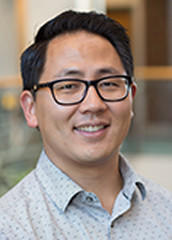
Hubert Lim, Ph.D.
E-MAIL: [email protected]
Research Interests:
The goal of my lab is to push the development and translation of brain-machine interfaces from scientific concept into clinical application with close collaboration with clinicians and industry. Brain-machine interfaces span a broad array of applications and consist of either direct connection of a device to neurons within the brain or neural communication through noninvasive techniques, such as EEG recordings and transcranial magnetic stimulation. The initial focus of my lab is to develop and improve implantable neural prostheses for restoring auditory function in deaf or hearing-impaired patients as well as those experiencing severe tinnitus (i.e., a phantom auditory percept that persists without any actual sound input). There are several auditory implants currently used in humans. This includes the cochlear implant (stimulates auditory nerve fibers), the auditory brainstem implant (stimulates the cochlear nucleus), and the auditory midbrain implant (stimulates the inferior colliculus), which my colleagues and I recently developed and translated into a clinical device. Some of these implants, as well as a few recent cortical devices, have also been used to suppress tinnitus. Although the outcomes have been encouraging, there are still many limitations with these devices, such as poor hearing in noisy environments and substantial variability in performance across patients. One fundamental limitation in improving these devices has been the lack of understanding of how the central auditory system in humans processes and represents sound information.
My lab employs various experimental and engineering techniques in animals (e.g., guinea pig, cat) and humans to understand the human brain and how to successfully implement a neural device. This includes acute and chronic implantation of electrode arrays into the animal brain to investigate how the auditory system codes for different sound features as well as the effects of electrical activation of multiple auditory and nonauditory pathways on sound coding and perception. Various electrophysiological and modeling techniques are also used to investigate the descending and plasticity circuitry of the auditory system, which is important for understanding how to improve and optimize stimulation strategies for restoring hearing as well as suppressing tinnitus. By performing EEG and psychophysical studies in humans in response to acoustic and electrical stimulation and linking these results to those obtained in animals, we then obtain a better understanding of sound processing within the human brain that can guide the development of the next generation of auditory implants.
Selected Publications:
(For a comprehensive list of recent publications, refer to PubMed, a service provided by the National Library of Medicine.)
- Hosseini M, Rodriguez G, Guo H, Lim HH, Plourde E. The effect of input noises on the activity of auditory neurons using GLM-based metrics. J Neural Eng. 2021 Feb 24. doi: 10.1088/1741-2552/abe979.
- Conlon B, Langguth B, Hamilton C, Hughes S, Meade E, Connor CO, Schecklmann M, Hall DA, Vanneste S, Leong SL, Subramaniam T, D'Arcy S, Lim HH. Bimodal neuromodulation combining sound and tongue stimulation reduces tinnitus symptoms in a large randomized clinical study. Sci Transl Med. 2020 Oct 7;12(564):eabb2830.
- Conlon B, Hamilton C, Hughes S, Meade E, Hall DA, Vanneste S, Langguth B, Lim HH. Noninvasive bimodal neuromodulation for the treatment of tinnitus: Protocol for a second large-scale double-blind randomized clinical trial to optimize stimulation parameters. JMIR Res Protoc. 2019 Sep 27;8(9):e13176.
- Guo H, Hamilton M 2nd, Offutt SJ, Gloeckner CD, Li T, Kim Y, Legon W, Alford JK, Lim HH. Ultrasound produces extensive brain activation via a cochlear pathway. Neuron. 2018;98(5):1020-1030.
- Lim HH, Lenarz T. Auditory Midbrain Implant: Research and development towards a second clinical trial. Hearing Res. 2015;322: 212-223.
- Berding G, Wilke F, Rode T, Haense C, Joseph G, Meyer GJ, Mamach M, Lenarz M, Geworski L, Bengel FM, Lenarz T, Lim HH. Positron emission tomography imaging reveals auditory and frontal cortical regions involved with speech perception and loudness adaptation. PLoS One. 2015 Jun 5;10(6):e0128743.
- Straka MM, Hughes R, Lee P, Lim HH. Descending and tonotopic projection patterns from the auditory cortex to the inferior colliculus. Neuroscience. 2015;300:325-337.
- Czanner G, Sarma SV, Ba D, Eden UT, Wu W, Eskandar E, Lim HH, Temereanca S, Suzuki WA, Brown EN. Measuring the signal-to-noise ratio of a neuron. Proc Natl Acad Sci U S A. 2015;112(23):7141-7146.
- Markovitz CD, Smith BT, Gloeckner CD, Lim HH. Investigating a new neuromodulation treatment for brain disorders using synchronized activation of multimodal pathways. Sci Rep. 2015 Mar 25;5:9462.
- Markovitz CD, Hogan PS, Wesen KA, Lim HH. Pairing broadband noise with cortical stimulation induces extensive suppression of ascending sensory activity. J Neural Eng. 2015 Apr;12(2):026006.
- Lim HH, Lenarz T. Auditory midbrain implant: research and development towards a second clinical trial. Hear Res. 2015;322:212-223.
- Lim HH, Shannon RV. Two Laskers and counting: Learning from the past enables future innovations with central neural prostheses. Brain Stimul. 2015;8(3):439-441.
- Offutt SJ, Ryan KJ, Konop AE, Lim HH. Suppression and facilitation of auditory neurons through coordinated acoustic and midbrain stimulation: investigating a deep brain stimulator for tinnitus. J Neural Eng. 2014 Dec;11(6):066001.
- Straka MM, Schmitz S, Lim HH. Response features across the auditory midbrain reveal an organization consistent with a dual lemniscal pathway. J Neurophysiol. 2014;112(4):981-98.
- Straka MM, McMahon M, Markovitz CD, Lim HH. Effects of location and timing of co-activated neurons in the auditory midbrain on cortical activity: implications for a new central auditory prosthesis. J Neural Eng. 2014;11(4):046021.
